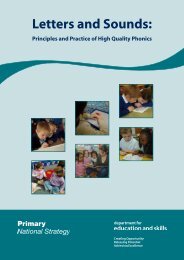Becta's ICT Advice services for teachers
Becta's ICT Advice services for teachers
Becta's ICT Advice services for teachers
You also want an ePaper? Increase the reach of your titles
YUMPU automatically turns print PDFs into web optimized ePapers that Google loves.
How to support children using <strong>ICT</strong><br />
Support assistants frequently work with individual pupils or groups of pupils. The children in a group may have similar<br />
abilities – they may have special educational needs (SEN) or be gifted and talented children – or have mixed abilities.The<br />
use of support assistants allows the class teacher to concentrate on the remainder of the class and to provide targeted<br />
support where it is most effective. When the focus of the activity is <strong>ICT</strong>-based, the role of the support assistant can be<br />
more complex because some pupils need help with the technology as well as with the subject they are studying.<br />
Support <strong>for</strong> the technology<br />
Pupils should be taught the skills and<br />
techniques needed to develop their <strong>ICT</strong><br />
capability. It is essential that a support<br />
assistant is familiar with the resources being<br />
used and can explain how to do things, and<br />
why. It is worth a support assistant spending<br />
time working through activities that pupils<br />
will be asked to do to identify where<br />
difficulties might arise.<br />
Some pupils need more support than others,<br />
and it may be necessary to develop a range of<br />
different activities to help them to learn.<br />
Activities with a very specific focus allow<br />
pupils to work on one technique at a time<br />
and, as their repertoire increases, techniques<br />
can be combined. For example, when pupils<br />
are learning how to highlight text and change<br />
its size, font style, colour or layout, they will<br />
probably find it easiest to practise one<br />
technique at a time. As they become more<br />
confident, they can create a poster.<br />
Pupils should be encouraged to look <strong>for</strong><br />
in<strong>for</strong>mation presented in a variety of ways<br />
from a very early age – <strong>for</strong> example, icons<br />
linking to speech and animations, and links<br />
to other pages. This helps them to become<br />
more independent.<br />
Similarly, when prompts are displayed on<br />
screen, encourage pupils to read them <strong>for</strong><br />
themselves and then carry out the<br />
instructions. Encourage poor readers to<br />
identify prompts on the screen (these may<br />
be in a different colour) and then attempt to<br />
read them, with support if necessary.<br />
When pupils struggle to remember<br />
processes, such as how to save a piece of<br />
work, it is often because they do not<br />
understand the process or they are not really<br />
thinking about what they are doing. Create<br />
memory aids to help with this. For example,<br />
write down and display the prompts and<br />
responses <strong>for</strong> a process. This approach works<br />
because pupils have to think about and<br />
articulate what they are doing, rather than<br />
follow a mechanical process.<br />
Illustrated help sheets should be available to<br />
support specific software and/or processes.<br />
Display them near the computer, either on the<br />
wall or in a file propped up at the side. Many of<br />
these can be downloaded from the internet.<br />
Alternatively, many publishers produce<br />
illustrated guides <strong>for</strong> office-type software.<br />
Using access devices<br />
Some pupils with special needs may find it<br />
helpful to use a specific access device. This<br />
may need to be moved between different<br />
locations, such as the <strong>ICT</strong> suite and the<br />
classroom. Find out how to do this to ensure<br />
that the pupil does not waste time. If<br />
appropriate, colour-code connections and<br />
prepare a simple set-up guide so that others<br />
can do it if you are away.<br />
Pupils will probably need some support<br />
be<strong>for</strong>e they can use the device effectively.<br />
Spend some time finding out how it works<br />
and exploring its potential. Many devices can<br />
be configured to meet individual needs, and<br />
it is usually through trial and error that the<br />
best set-up is found.<br />
Managing <strong>ICT</strong> activities<br />
Organising and managing groups<br />
It is important that work is planned to ensure<br />
that it meets the requirements of the<br />
National Curriculum and the individual<br />
needs of the pupils. When using <strong>ICT</strong> it is<br />
important to consider:<br />
● the target audience – does the activity<br />
meet the needs of one pupil or a small<br />
group?<br />
● the basis of the group – is it ability, age,<br />
gender or friendship?<br />
● individual needs and personalities within<br />
the group – will some pupils be too<br />
dominant, too intimidated, or frustrated<br />
because of lack of challenge?<br />
● the most effective strategies to make<br />
groups work well together – will pupils<br />
need their roles defining and need timed<br />
intervention to ensure that everyone gets<br />
a turn, or should they be encouraged to<br />
organise themselves?<br />
● how learning objectives will be<br />
communicated to pupils<br />
● how learning will be assessed.<br />
Making a start<br />
If the software can be configured or<br />
differentiated to meet the needs of<br />
individual pupils, ensure that you know<br />
passwords and any other in<strong>for</strong>mation<br />
necessary to do this. In addition, you may like<br />
to think about:<br />
● learning objectives<br />
● support materials<br />
● pupils’ <strong>ICT</strong> skills – can they carry out the<br />
activity effectively?<br />
● group size<br />
● time available.
















